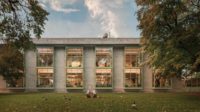Sag Harbor House by Ted Porter Architecture
Sag Harbor, New York

While architect Ted Porter adhered to historic guidelines for the street facade of the 1920s house in Sag Harbor, Long Island, he was able to open up the volumes at the back.
Photo © Jeffrey Brandsted

While architect Ted Porter adhered to historic guidelines for the street facade of the 1920s house in Sag Harbor, Long Island, he was able to open up the volumes at the back.
Photo © Jeffrey Brandsted

The large rear window brings light inside.
Photo © Jeffrey Brandsted

White oak tongue-and-groove panels clad all interior surfaces (no gypsum board!), as shown by the switchback stair.
Photo © Jeffrey Brandsted

On the second floor, Porter pushed the ceiling of a guest bedroom into the attic for height and reused preexisting doors for the closets.
Photo © Jeffrey Brandsted

Image courtesy Ted Porter Architecture

Image courtesy Ted Porter Architecture







Architects & Firms
“Unprepossessing” is an apt way to describe the 1920s colonial revival house that Ted Porter found in 1999 in Sag Harbor, Long Island, and finished renovating for himself and his partner, Steve Godeke, last year. The New York–based architect with his own practice wanted a weekend home in this picturesque former whaling village, and the location, within walking distance of Main Street, was ideal.
Additional Content:
Jump to credits & specifications
But its small rooms and low ceilings (7 feet, 11 inches high) were constraining, and local codes and guidelines restricted how much could be made of the two-story, 1,900-square-foot cottage. First, it is a “contributing structure” to a National Historic District, which meant the town’s Board of Historic Preservation and Architectural Review declined to allow significant changes to the street facade. Second, zoning prevented a house on such a small site—.22 of an acre—from expanding beyond its footprint or height.
Not surprisingly, the review board had no problem with Porter’s replacing the aluminum clapboard and asphalt roofing—both transmogrifications made some years ago—with cedar shingles of the original design. But other than this upgrade and the inclusion of boxwood, Japanese maple, and cloud-pruned yew in the front yard, there is little clue from the street of an architect’s extensive intervention.
But upon entering, you find an open, airy interior. Everywhere, white oak clads floors, walls, and even ceilings—punctuated by splashes of color in furnishings, objets d’art, and other accoutrements. “While I was designing the house, I visited Alvar Aalto’s architecture in Finland,” says Porter in reference to combining a modernist vocabulary with natural materials. The effect is warm (literally, helped in the winter by the insulation added to the wood frame, and a newly redesigned fireplace in the living room).
To create light-filled volumes, Porter opened up the rooms to the rear: he lifted the ceiling of the living area to a 10½-foot height, and installed a literal “picture window"—9½ by 8 feet and triple-glazed—to frame the view of the lush back garden. Jutting out to the back, too, is a remodeled screened porch, 10½ feet tall, which overlooks European beech trees that conceal a small lap pool beyond.
The desire for higher ceilings required Porter to raise most of the second floor 3 feet and push the ceilings of these rooms into the former attic, where they reflect the slopes of the gable. Now a guest bedroom, library, and a new sun-room (above the screened porch) complement the one-story master bedroom suite at one end of the first floor.
In connecting the two levels, Porter removed the straight stair perpendicular to the entrance and inserted a switchback one to the right of the door. To keep the incline of the first flight low enough so it would not obstruct the two windows facing the street, Porter designed deep treads with shallow risers: as the stair turns back to ascend to the upper hall, it reassumes normal dimensions.
Through these basic, if complicated and painstakingly crafted moves—inserting a new stair, raising ceiling heights, adding ample expanses of glass, and cladding surfaces in wood—Porter has demonstrated a timeworn precept: innovation is born of necessity. Constraints, to repeat the key word, often are a good thing.
CreditsArchitect: Ted Porter Architecture 45 West 21st Street, Suite 4A New York, NY 10010 212-254-1175
Personnel in architect's firm who should receive special credit: Ted T. Porter, AIA, Principal in Charge Joerg Thoene, AIA Noelia Linares
Architect of record: Ted Porter Architecture
Interior designer: Ted Porter Architecture
Engineers: Structural: Edward Armus Engineering
Consultants: Lighting: Star Lighting Design
General contractor: Philip Manuele Contracting
Photographer: Jeffrey Brandsted |
SpecificationsExterior Cladding Masonry: Glen-Gery Wood: 18” Red Cedar Perfection Shingles Moisture barrier: Intello Plus
Roofing Elastomeric: Henry Tile/shingles: 18” Red Cedar Perfection Shingles with Pre-Weathered Stain
Windows Wood frame: Marvin (Front Windows on Historic Façade) Wood frame: Cembra (Rear Windows on Garden Façade)
Doors Entrances: Trustile Wood doors: Trustile Sliding doors: Cembra Special doors: Bilco Roof Hatch
Hardware Locksets: Valli and Valli Pulls: Valli and Valli
Interior Finishes Cabinetwork and custom woodwork: Rob Russell Design and Millwork Paints and stains: Bona Paneling: Clear White Oak Tongue and Groove Center Match 6” Wide Boards Solid surfacing: PentalQuartz Floor and wall tile: Opus Cliff Natural (Bathroom Floors), Metro Gloss White Tiles (Bathroom Walls) Raised flooring: Floor is Clear White Oak Tongue and Groove Center Match 8” Wide Boards Special interior finishes unique to this project: Ceilings are Clear White Oak Tongue and Groove Center Match 6” Wide Boards Special interior finishes unique to this project: Re-used Antique Wood Doors from Original House for Paneling in Guest Bedroom
Furnishings Chairs: Maruni (Dining Chairs) Tables: Gubi from SuiteNY (Dining Table) Upholstery: Clarence House, Kravet Other furniture: Tecta (Sofa) Other furniture: USM Modular Furniture (Bedside Tables) Other furniture: Vitra (Artek Aalto Bench) Other furniture: Vintage by Owner
Lighting Interior ambient lighting: Globall by Flos Interior ambient lighting: Sonneman Downlights: Swidlux by Nulux Downlights: Element by Tech Lighting Tasklighting: Tolomeo by Artemide, Exterior: Copper LED by BOOM Collection Dimming system or other lighting controls: Lutron
Plumbing Bathroom Sink: Duravit Bathroom Sink Vanity: Duravit Bathroom Faucets: Speakman Shower Faucets: Grohe Bathtub: Kohler Toilets: American Standard Bathroom Accessories: Moen Kitchen Sink: Kraus Kitchen Faucet: Delta
Energy Other unique products that contribute to sustainability: Navien Combi-Boiler / Water Heater Add any additional building components or special equipment that made a significant contribution to this project: Rockwool Batt Insulation |













